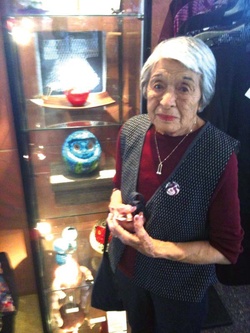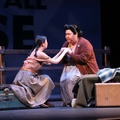When Carol Misumi laughs, she sounds more like 19 than 91, but this California native was indeed born in 1919. The retired home economics teacher uses her talents in design and sewing to continue her long-time support of the Japanese American National Museum (JANM). Working from her home in Santa Barbara, Carol crafts unique items, such as wall hangings and purses, from vintage Japanese textiles that are sold in the Museum’s store.
As Carol talked about her life, laughing easily and often, the unifying threads running through her story were both practical and adventuresome. That sense of adventure had a hand in the journey that Carol’s father, Tsunetaro Tanaka, took from Kumamoto, Japan to California. As an only son, he was expected to stay home and work the family farm but instead, he announced his intention to become a policeman or else head off to America. According to Carol, his parents “called his bluff” and her father left home at age 18, bound for California in 1900.
Carol’s mother, Tsuyo, also from Kumamoto, arrived in San Francisco in 1906. “I guess you would call her a picture-bride,” said Carol. “It was right after the earthquake when the city was still in ruins.” Newly married, the Tanakas settled in Colusa, near Sacramento, where they were farm workers. They moved frequently, mostly within the San Joaquin Valley, adding seven children to the family before moving to Boyle Heights.
Boyle Heights, an East Los Angeles gateway community for new immigrants, had a sizeable Japanese population in 1940. Just out of high school, Carol socialized with other young Japanese Americans through a group affiliated with the local “Y.” However, in 1942, the ethnic makeup of Boyle Heights rapidly changed. Along with most of the area’s ethnic Japanese, the Tanakas were incarcerated at Manzanar and like many other families, did not return to Boyle Heights after their release.
Instead of going to a concentration camp, two of Carol’s brothers fled on their own to Idaho where they worked on a sugar beet farm. Another went to Colorado because he had a friend there, and worked as a gardener and farm laborer. Her youngest brother was still in high school so he went to Manzanar and graduated from high school there. Her two younger brothers later volunteered for the 442nd and served overseas. Sadly, John Yukio Tanaka was killed in action in Southern France. Her two older brothers were later drafted, but because they were married and had children, they served stateside. Carol also had a sister who was in the Army Nurse Corps and served in Germany, Japan, and Korea.
In memory of John, Carol’s family donated to the Museum and had John’s name inscribed on one of the walls of the Hirasaki National Resource Center. His Silver Star medal and commendation, as well as other army memorabilia were donated to the Museum; all of which are now a part of the exhibition Common Ground: The Heart of Community.
Carol didn’t comment much on her incarceration experiences, saying only that her stay was relatively brief and that her father had been sick in camp. After about a year, she was released and moved to Denver, Colorado. Her parents were released soon after and also relocated to Denver.
Starting over after release from Manzanar, Carol worked as an aide at Denver’s Children’s Hospital and was an active member of a Japanese Methodist Church. She had always wanted to go into teaching but put that goal on hold, working as a secretary for more than ten years. However, once her brother finished his degree at the University of Denver, Carol seized her chance to fulfill her dream, deciding to enroll at San Francisco State University when she was 35 years old. Certainly, there were schools closer to home but “I guess I just wanted to be in San Francisco,” admits Carol. It definitely required a sense of adventure to not only move across country but to take a seat in classes attended by students little more than half her age. Undeterred, Carol knew what she wanted to do.
Carol had long been interested in working with fabrics, possibly influenced by her mother who had learned to weave as a young girl in Japan. Asked if her mother had continued to practice those traditional skills in America, an amused Carol replied “with seven children, my mother had her hands full.” Carol decided to major in clothing and textiles, and upon graduation, she became a Home Economics teacher.
Carol also met her husband, James Misumi, in San Francisco. Before the war, he had been sent to Japan for his education, a kibei, and had been trapped there until the war was over. He eventually returned, employed by a Japanese company in San Francisco, while Carol spent twenty-five years in the city’s school system, teaching Home Economics. Working within a defined curriculum, Carol’s cultural heritage did not play a part in her lesson plans, yet her interest in Japanese textiles never faded. She collected old kimonos and fondly remembers a particular fabric store in Berkeley that carried a good selection of Japanese fabrics. Family visits to Japan offered the opportunity to scout out material, too.
About ten years ago, the Misumis moved to Santa Barbara. Retirement has offered Carol the time to indulge in her hobby. “I’ve always liked to sew,” said Carol. “My sisters weren’t too interested.” She creates her own designs or sometimes alters patterns, keeping in mind the need to work within the 14" width that limit traditional textiles. “That’s why kimonos are pieced together as they are, every seam straight with no curves,” explained Carol.
“When I started, I didn’t know what I would do with my hobby. I just thought I might as well do something worthwhile.” That’s why Carol, a JANM member for more than twenty years, decided to contact Maria Kwong, Director of Retail & Visitor Services at the museum. Maria notes that Carol uses only vintage textiles from her personal collection. “The textiles vary but are primarily shibori, kasuri, and other indigo fabrics. Her pieces are one-of-a-kind,” writes Maria. Proceeds from the sale of these handicrafts benefit the Museum. Although Carol modestly claims that she’s just glad to have something to do, she uses her skills and the materials she already has on hand to make a valuable contribution despite living too far away to volunteer on-site.
As Carol uses up her supply of vintage textiles, most of her fabric remnants are now too small to make clothing but they are perfect for quilting. “I want to quilt. It takes a lot of time but it would keep me busy,” said Carol. She’s a wonderful example of the many ways dedicated volunteers support JANM. “Perhaps others will think about their various talents and find a way to help.” Like piecing together scraps of fabric, Carol uses what she has and what she knows to support what she loves. But she’s also looking forward to hopping a train to Los Angeles for a visit to the Museum and a stay at the Miyako Hotel. As always, Carol Misumi is practical and adventurous.
© 2010 Japanese American National Museum






